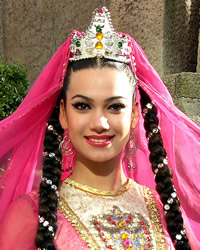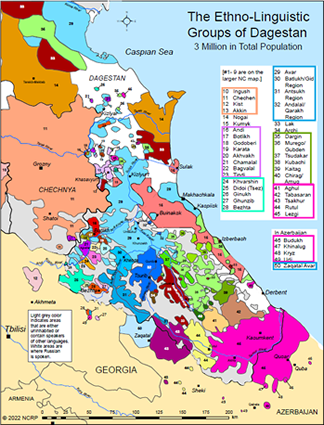The dynamic young Lezgin man, imitating the eagle, fell to his knees, leapt up and twirled with rapid foot movements, with his outstretched arms swooping above him. Nearby, but not touching him, the gracious Lezgin woman, with demure hand movements and light artistic footwork, appeared to be floating across the floor as she responded symmetrically to the male dance. Celebrating a village wedding, the two were dancing the Lezginka, the world-famous dance with its origins in the Lezgin people of the eastern Caucasus region. Or, perhaps, they were dancing the Lezginka on the stage of a packed-out theatre in front of 1000s in London or Munich or Moscow. The ancient folk dance of the Lezgin people expresses the proud history and cultural dynamism of the Lezgins of southern Russia and northern Azerbaijan.
In the 90 Lezgin towns and villages of Dagestan the Lezgin raise sheep and goats, combined with subsistence agriculture, leather working, and textile production [famous hand woven carpets]. Life is similar in the more than 50 Lezgin towns and villages of northern Azerbaijan; with the exception that in Dagestan Russian serves as the 2nd language, whereas Azeri is the second language for Lezgi in Azerbaijan. The Lezgi language, however, is alive and well—with robust oral activity in Lezgin villages, homes, and schools; and a huge reservoir of Lezgi literature and music. Many Lezgin have also out-migrated from rural Lezgin regions to urban areas of Dagestan and Azerbaijan, primarily for economic reasons. Patriarchal social structure among the Lezgin remains strong, especially in village life and in demarcated urban enclaves.
Islamic power swept into the Caspian seacoast region of the Lezgin people already in the 7th and 8th Centuries and has carried huge influence into Lezgi society over the past 1000 years. By the end of the 18th Century, the Lezgin people were considered 100% Muslim. Spiritism and animistic practices are also widespread in Lezgin culture. Rags are tied on holy trees or near holy graves to seek spiritual assistance for health or marriage or economic good fortune. Soothsayers are frequently consulted.
As epitomized in the majestic Lezginka, there is a nobility in ancient Lezgin culture. This, however, as elsewhere in the world, does not leave the people immune to the effects of sinful human nature. And neither spiritism nor Islam provides the cleansing forgiveness of Jesus or the regenerating power of the Holy Spirit. In the past two decades there are now more than 75 Lezgin followers of Jesus in Dagestan, and more than 100 Lezgin believers in Azerbaijan. Pray for their influence to spread and multiply. Of great significance is progress in Lezgi Bible translation. The Four Gospels and Acts and a Children's Bible have been published in Lezgi, and sixteen additional NT books are in process. From the OT, Ruth, Esther and Jonah have been published, and ten more OT books are in process. There is a strong Bible translation team, including Lezgin believers. This work connects with the heart of Lezgi language and culture. An ancient text in a Lezgi tribal language, from pre-Islamic times, even contains Bible translation portions.
Pray that the best of noble Lezgin culture will be infused with the regenerating power of Jesus' grace.
Pray for the Lezgin believers to shine as bright lights in the midst of their Lezgi families and clans.
Pray for men and women of peace in each one of the more than 142 Lezgi towns and villages, to be keys to welcoming the love of God, the grace of Jesus, and the power of the Holy Spirit into each Lezgi community.
Give thanks for the Translation work which is underway. Pray for wide reading and spiritual understanding.
Pray for many Lezgin people to dance, full of the joy of the Holy Spirit, in the years to come.
Scripture Prayers for the Lezgin in Azerbaijan.
https://www.everyculture.com/Russia-Eurasia-China/Lezgins-History-and-Cultural-Relations.html
https://everything.explained.today/Lezgins/
| Profile Source: Joshua Project |
| Other PDF Profile |











